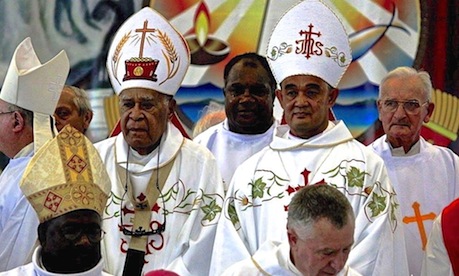La mitre et la crosse pour un jeune archevêque de Suva, de Rotuma, de Rarotonga et de Kiribati. Il a 52 ans, s’appelle Peter Loy Chong, il est d’origine chinoise mais d’une famille intégrée à Fidji depuis des générations.
Et il est devenu samedi le quatrième archevêque, succédant ainsi à Mgr Petero Mataca, 78 ans, qui, frappé par la limite d’âge, avait renoncé à ces fonctions il y a déjà trois ans. Il était archevêque de Suva depuis 1976, 37 ans, un record.
Depuis, on attendait un signe du Vatican et finalement, son successeur a été nommé en décembre dernier par le Pape d’alors, Benoît XVI.
Samedi, devant une foule très émue de quinze mille personnes à Suva, le nouvel archevêque, spécialiste en théologie et en droit canon, Jésuite et qui a longtemps étudié aux États-Unis, a été officiellement intronisé, sur fond de savant mélange de rites chrétiens, mais aussi de traditions coutumières.
Pour preuve : son blason, conçu pour l’occasion, accorde une place de choix aux signes identitaires fidjiens, y compris le kava et la dent de cachalot, cadeau coutumier de grande valeur dans la tradition fidjienne.
The miter and crosier for a young Archbishop of Suva, Rotuma, Rarotonga and Kiribati. He is 52 years old, called Peter Chong Loy, He is of Chinese origin but his family has been integrated into Fiji for generations.
Be became the fourth Archbishop Saturday,(June 8) succeeding Archbishop Petero Mataca, 78, who, having arrived at the age of retirement, had given these functions it three years ago. He has been Archbishop of Suva since 1976, 37 years, a record.
Since that time some indictication from the Vatican has been expected and finally, his successor was appointed last December by the then Pope, Benedict XVI.
On Saturday (8 June), before a very excited crowd of fifteen thousand people in Suva, the new Archbishop, who has for a long time studied in the United States specializing in theology and canon law, was officially enthroned amid mixture of Christian rites, but also customary traditions.
Proof: His Coat of arms, designed for the ccasion, gives pride of place to Fijians symbols , including kava and sperm whale tooth, both customary gift of great value in the Fijian tradition
- Moana (the Polynesian term for ocean) is also an Oceania symbol used by some theologians to express God.
- Magimagi or sinnet rope (made from coconut husk) represents the globalised world of which Fiji is a part. The interweaving threads symbolise how globalisation is a key concept for the church. The church cannot remain isolated from economic, cultural and socio-political issues that affect the people.
- Archbishop Peter Loy’s coat of arms also incorporates elements of the plurality of Fiji’s society. The tabua represents the iTaukei (indigenous) peoples, the diyaa represents Fiji’s Indian population and symbolises the victory of good over evil. It can also be taken to mean the “submission of one’s soul to the supreme power.”
- The fish represents the Chinese culture’s symbol of unity and fidelity.
- The islands represent Rabi, Kioa and Rotuma which come under the Archdiocese of Suva.
- The four white panels emanating from the cross represent the four gospels.
- “The slogan ‘to be church in the world’ reflects my vision of the Church. To be a true Church of Jesus Christ, the Church must permeate the world with the gospel,” Father Peter Loy was quoted as saying.
Source
Additional reading- The message of the newly ordained Archbishop of Suva Peter Loy Chong
- Former MP lauds event
- Mataca's word of advice
News category: Asia Pacific.




